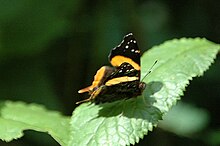
Vanessa atalanta, the red admiral or, previously, the red admirable, is a well-characterized, medium-sized butterfly with black wings, red bands, and white spots. It has a wingspan of about 2 inches (5 cm). It was first described by Carl Linnaeus in his 1758 10th edition of Systema Naturae. The red admiral is widely distributed across temperate regions of North Africa, the Americas, Europe, Asia, and the Caribbean. It resides in warmer areas, but migrates north in spring and sometimes again in autumn. Typically found in moist woodlands, the red admiral caterpillar's primary host plant is the stinging nettle ; it can also be found on the false nettle. The adult butterfly drinks from flowering plants like Buddleia and overripe fruit. Red admirals are territorial; females will only mate with males that hold territory. Males with superior flight abilities are more likely to successfully court females. It is known as an unusually calm butterfly, often allowing observation at a very close distance before flying away, also landing on and using humans as perches.

The swamp rabbit, or swamp hare, is a large cottontail rabbit found in the swamps and wetlands of the southern United States. Other common names for the swamp rabbit include marsh rabbit and cane-cutter. The species has a strong preference for wet areas, and it will take to the water and swim.

The red-bellied paradise flycatcher, also known as the black-headed paradise flycatcher, is a medium-sized passerine bird of the family of monarch flycatchers. It is native to intra-tropical forests of Africa. The male bird is about 17 cm (7 in) long and has a black head, a mainly chestnut body, and a tail with streamers nearly twice as long as the body. The colouring is somewhat variable across the bird's range. Both females and juveniles lack the tail streamers and are a duller brown colour. It is closely related to the African paradise flycatcher, and the two can hybridise.
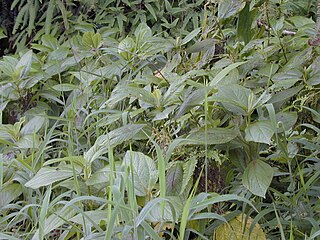
Boehmeria is a genus of 47 species of flowering plants in the nettle family Urticaceae. Of the species, 33 are indigenous to the Old World and 14 to the New World; no species is indigenous to both the Old and New Worlds. The species include herbaceous perennials, shrubs and small trees. Although related to the similar-looking species of the stinging nettles of genus Urtica, species of Boehmeria do not have stinging hairs. Because of the similarity in appearance, some species are commonly called "false nettles".

Vanessa indica, called the Indian red admiral or the Asian admiral in the United States, is a butterfly found in the higher altitude regions of India, primarily the Himalayas and the Nilgiri Hills. It is also found in Sri Lanka and Myanmar, China, Korea, SE Russia, Japan. It is a close relative of the painted lady.

Vanessa is a genus of brush-footed butterflies in the tribe Nymphalini. It has a near-global distribution and includes conspicuous species such as the red admirals, the Kamehameha, and the painted ladies of the Cynthia group : Painted lady, American painted lady, West Coast lady, Australian painted lady, etc. For African admirals, see genus Antanartia. Recently, several members traditionally considered to be in the genus Antanartia have been determined to belong within the genus Vanessa.

The long-tailed hermit is a large hummingbird that is a resident breeder in Venezuela, the Guianas, and north-eastern Brazil. This species was formerly referred to as the eastern long-tailed hermit.

Nymphalini is a tribe of nymphalid brush-footed butterflies. Common names include admirals, anglewings, commas, and tortoiseshells, but none of these is specific to one particular genus.
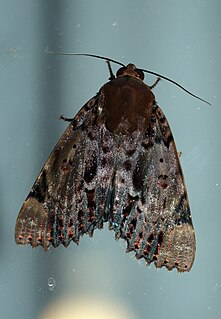
Arcte coerula, the ramie moth, is a moth of the family Noctuidae. The species was first described by Achille Guenée in 1852. It is found from in south-east Asia, including Fiji, India, Sri Lanka, Myanmar, Japan, New Guinea, Taiwan and Norfolk Island. It has been recently observed in Hawaii, on the island of Maui.

Antanartia, commonly called (African) admirals, is a genus in the family Nymphalidae found in southern Africa. They live along forest edges and are strongly attracted to rotting fruit and plant juices. For other admirals see genus, Vanessa. Recently, three species traditionally considered to be members of Antanartia have been moved to Vanessa based on molecular evidence. Antanartia borbonica was not sampled by the study, but was purported to belong in Antanartia based on morphological similarity.

Prodryas persephone is an extinct species of brush-footed butterfly, known from a single specimen from the Chadronian-aged Florissant Shale Lagerstatte of Late Eocene Colorado. P. persephone is the first fossil butterfly to be found in North America, and is exquisitely well preserved. Its closest extant relatives are the mapwings and African admirals of the genera Hypanartia and Antanartia, respectively.
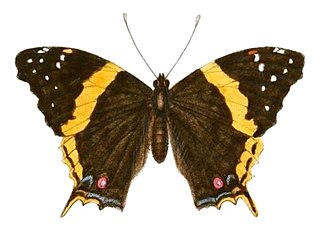
Vanessa hippomene, commonly known as the southern short-tailed admiral, is a butterfly of the family Nymphalidae which is native to South Africa and Madagascar.
Vanessa dimorphica is a butterfly of the family Nymphalidae. It is found in Africa.
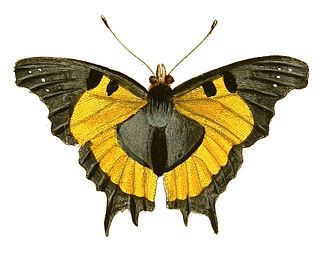
Antanartia delius, the forest admiral or orange admiral, is a butterfly in the family Nymphalidae. It is found in Senegal, Sierra Leone, Liberia, Ivory Coast, Ghana, Nigeria, Cameroon, Equatorial Guinea, the Republic of the Congo, Angola, the Democratic Republic of the Congo, Uganda, Kenya and Tanzania. The habitat consists of lowland forests.

Vanessa abyssinica, the Abyssinian admiral, is a butterfly in the family Nymphalidae. It is found in Ethiopia, Kenya, Tanzania, Uganda, Rwanda and the Democratic Republic of the Congo. The habitat consists of montane forests.
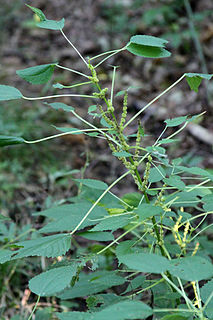
Boehmeria cylindrica, with common names false nettle and bog hemp, is an herb in the family Urticaceae. It is widespread in eastern North America and the Great Plains from New Brunswick to Florida to Texas to Nebraska, with scattered reports of isolated populations in New Mexico, Arizona, and Utah, as well as in Bermuda, Mexico, Central America, the West Indies, and South America.
Boehmeria calophleba is a flowering plant in the nettle family.
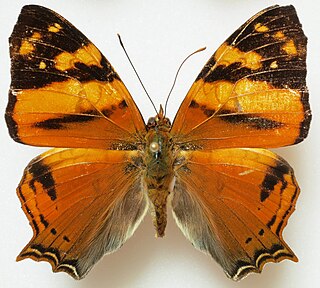
Hypanartia lethe, the orange admiral or orange mapwing, is a butterfly of the family Nymphalidae.
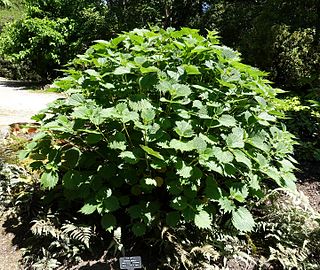
Boehmeria japonica is a species of flowering plant in the nettle family (Urticaceae). It native to eastern Asia, where it is found in China, Japan, South Korea, and Taiwan.
